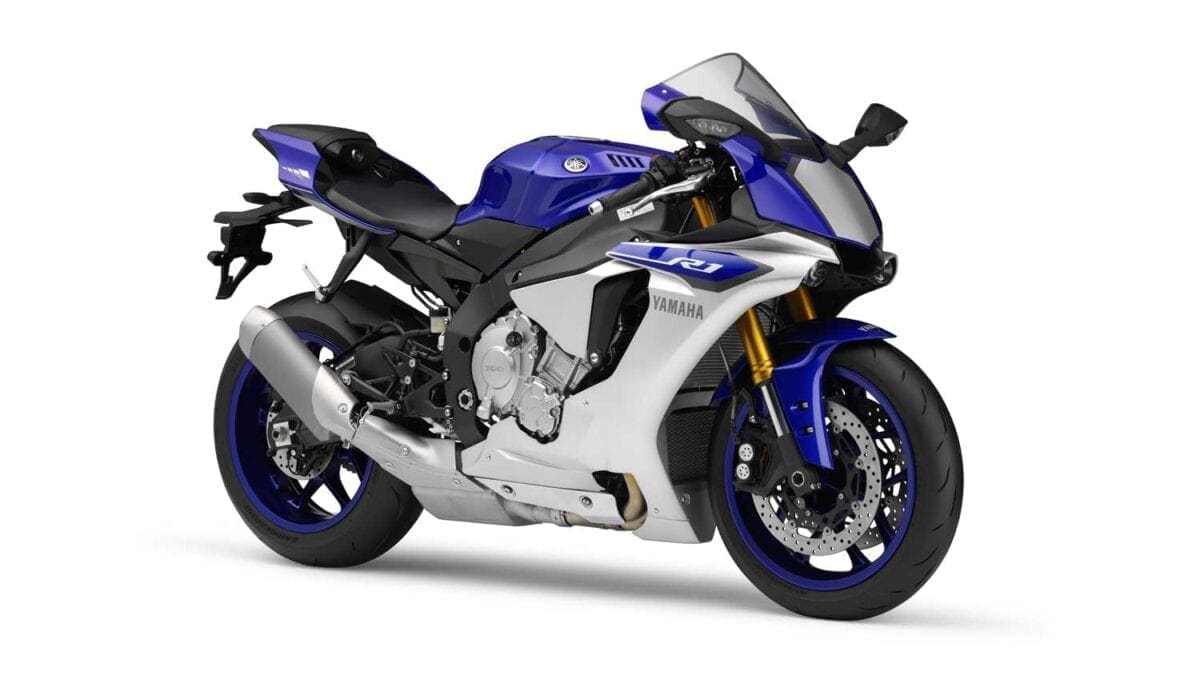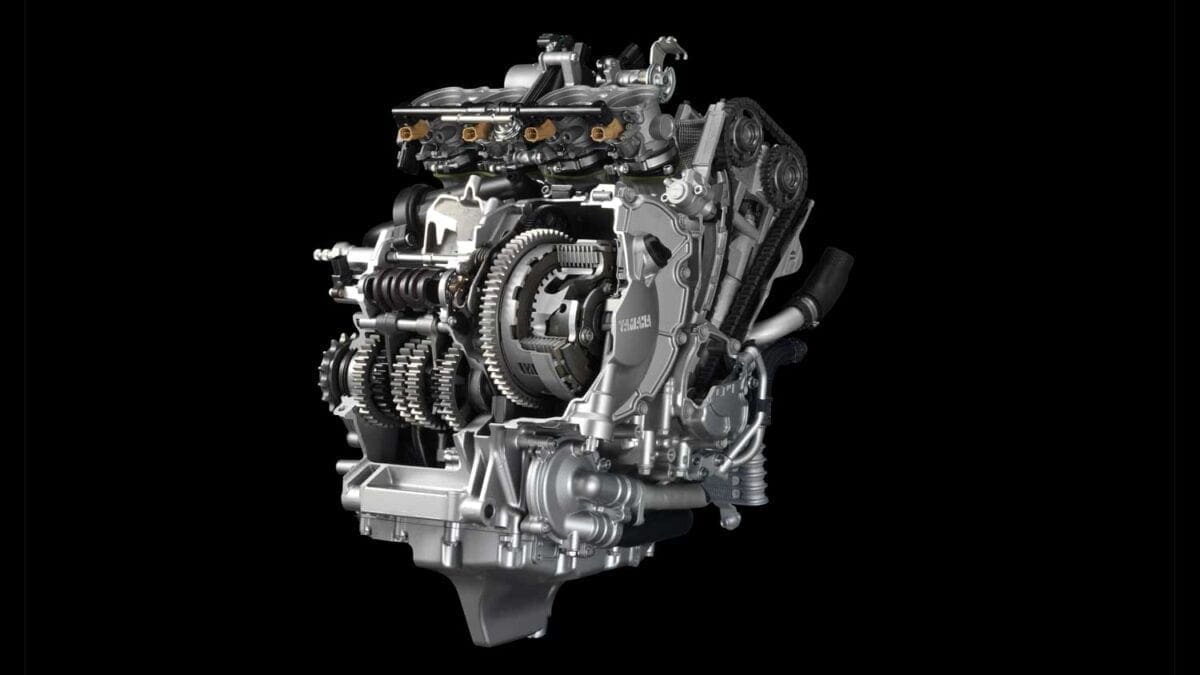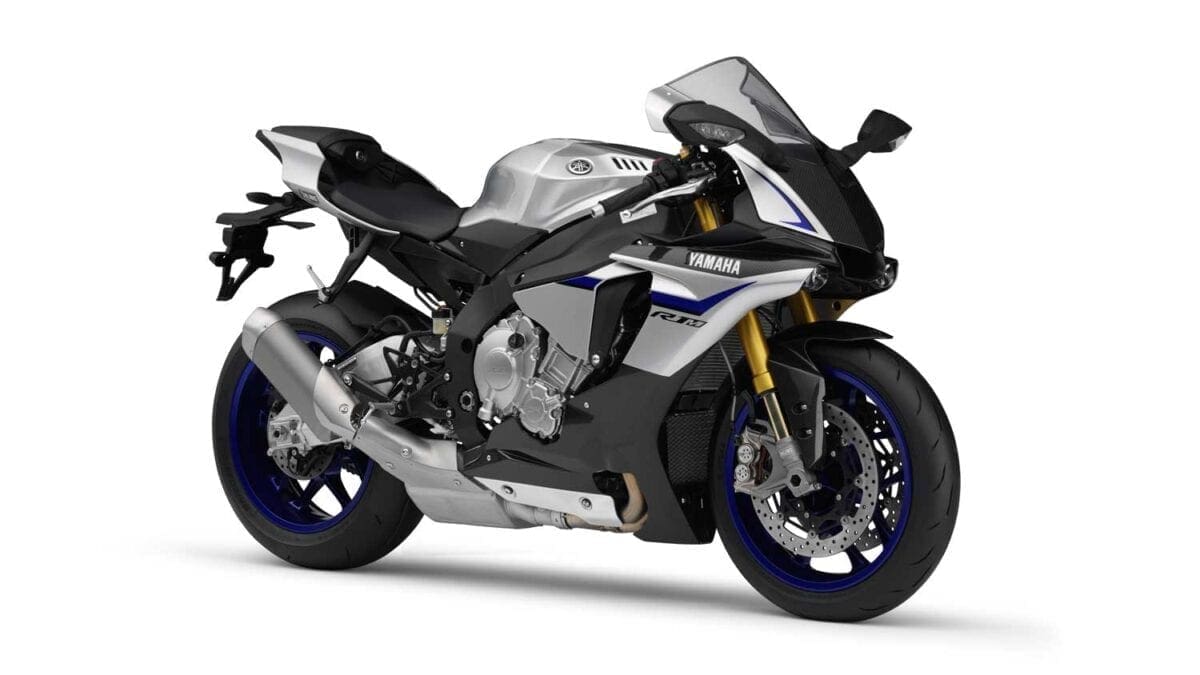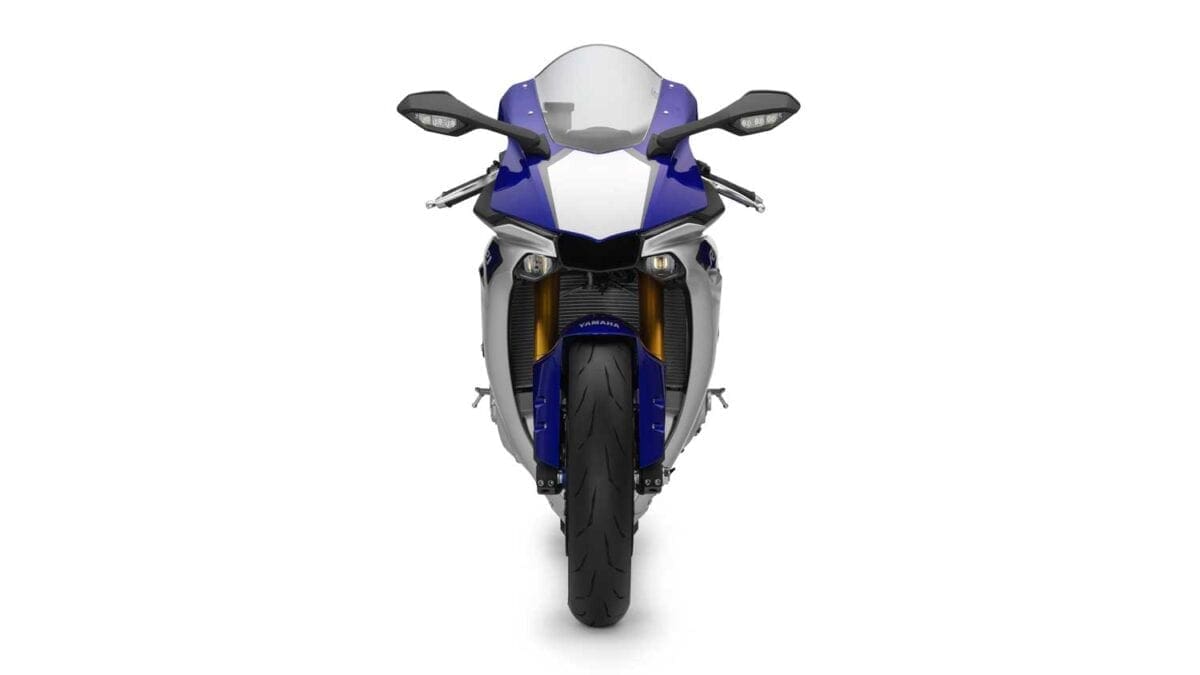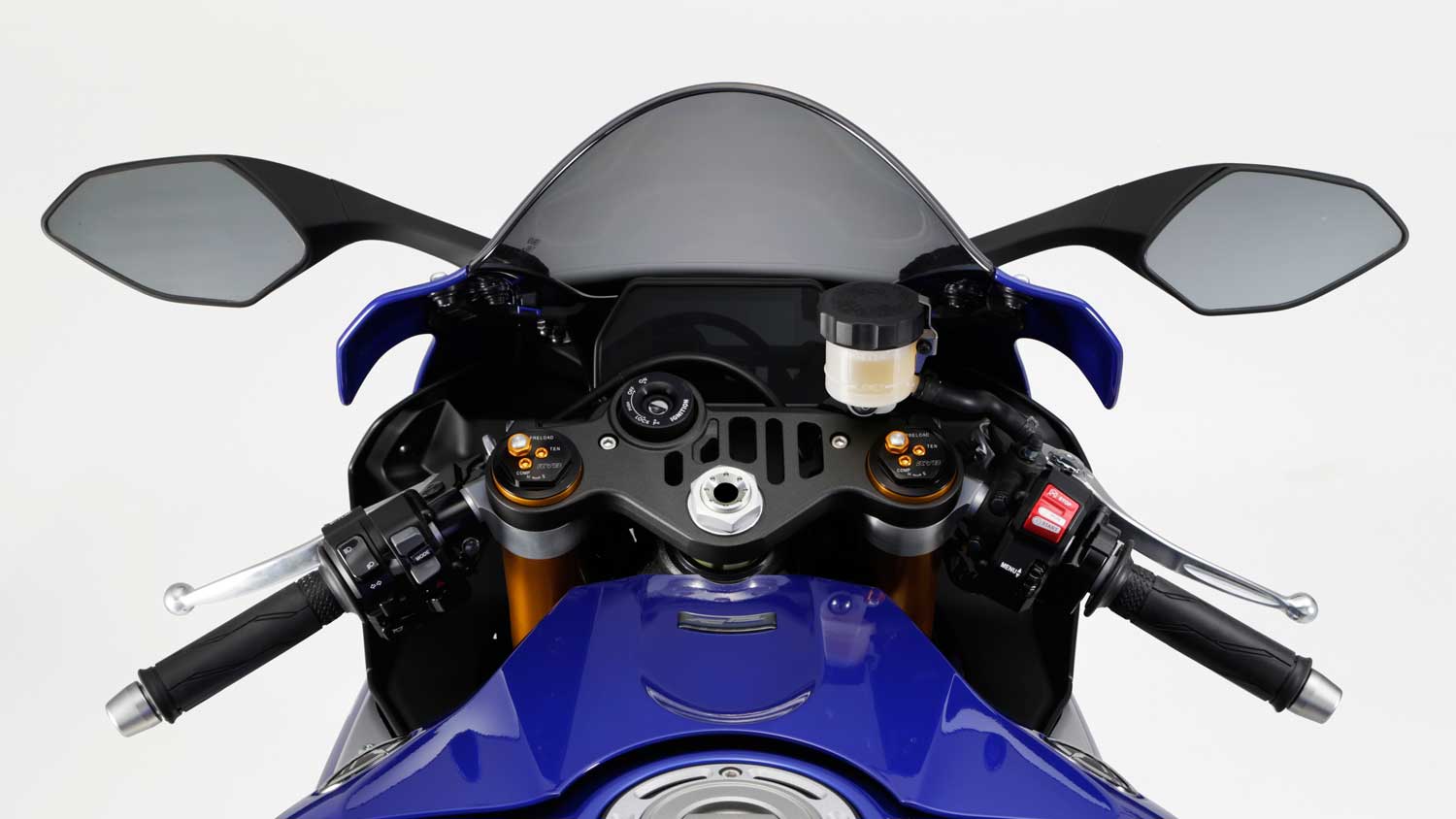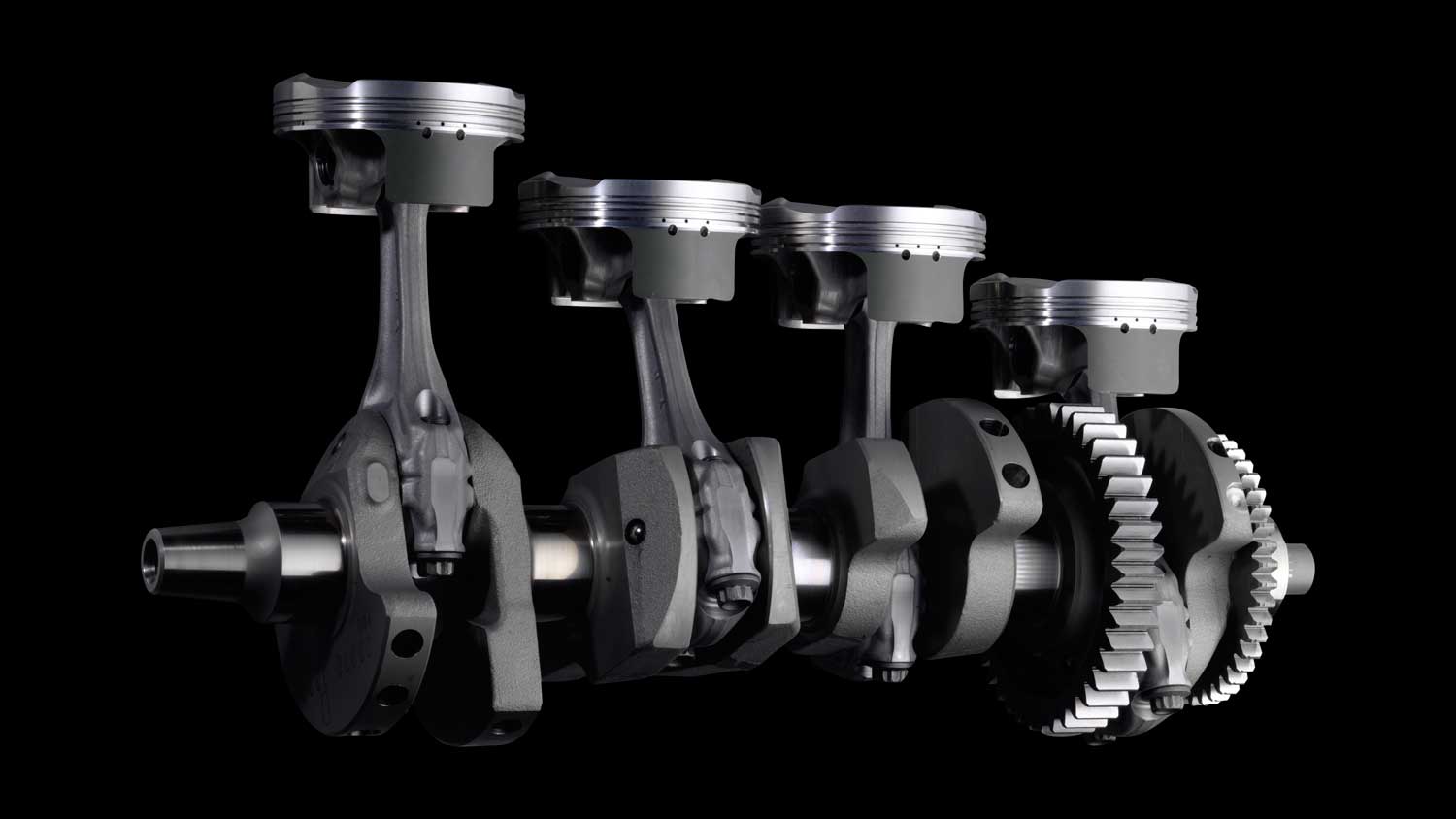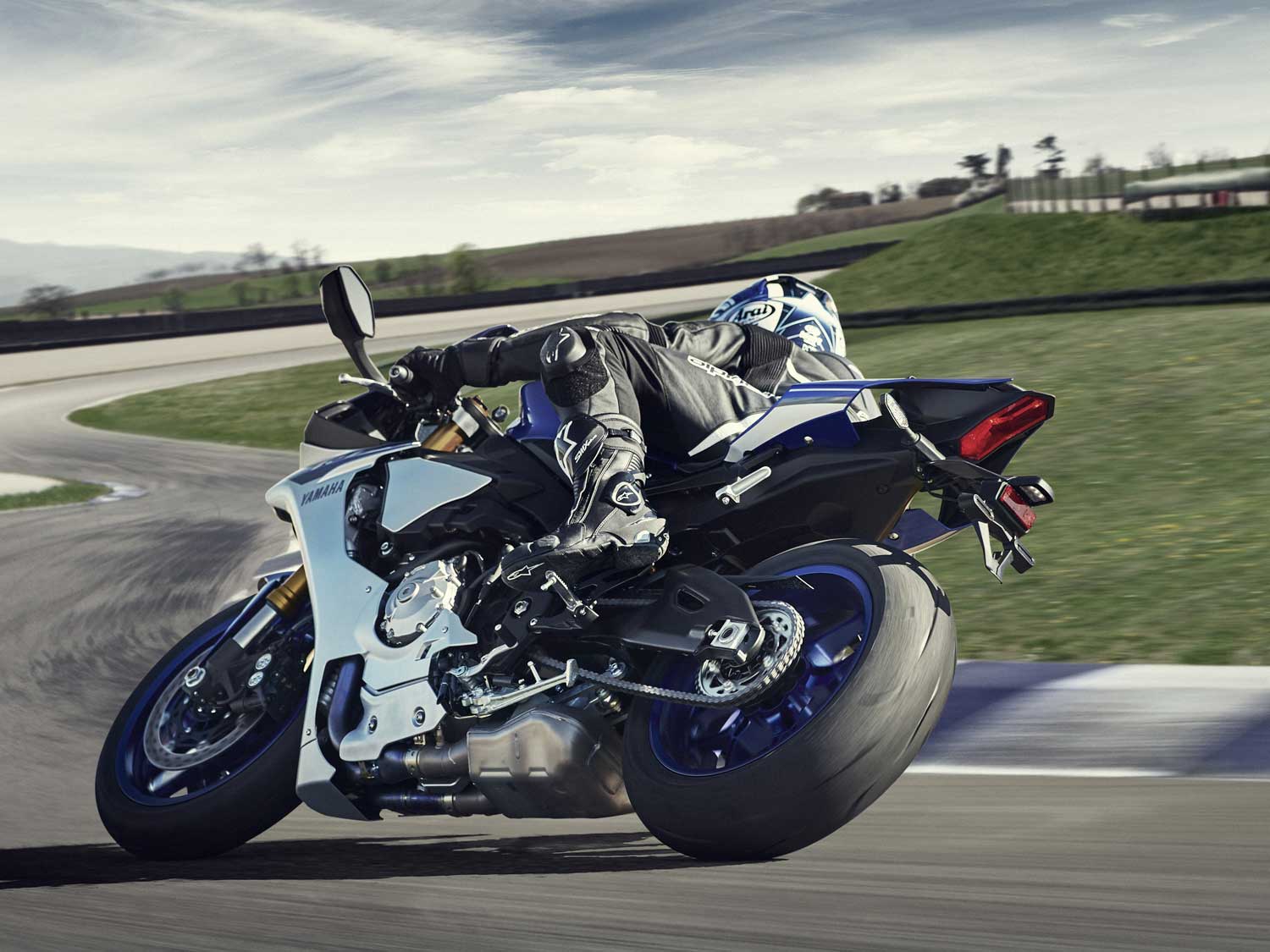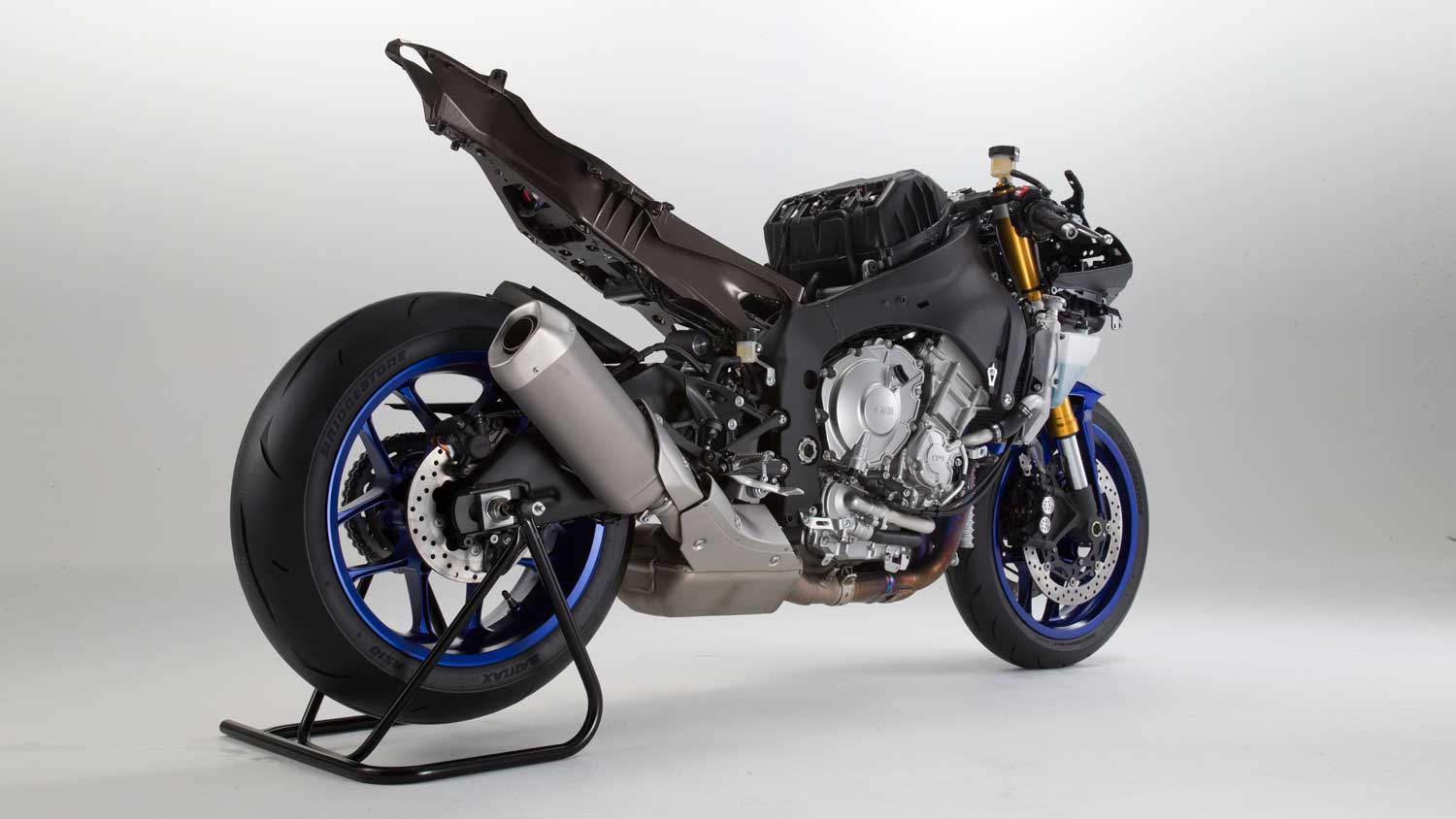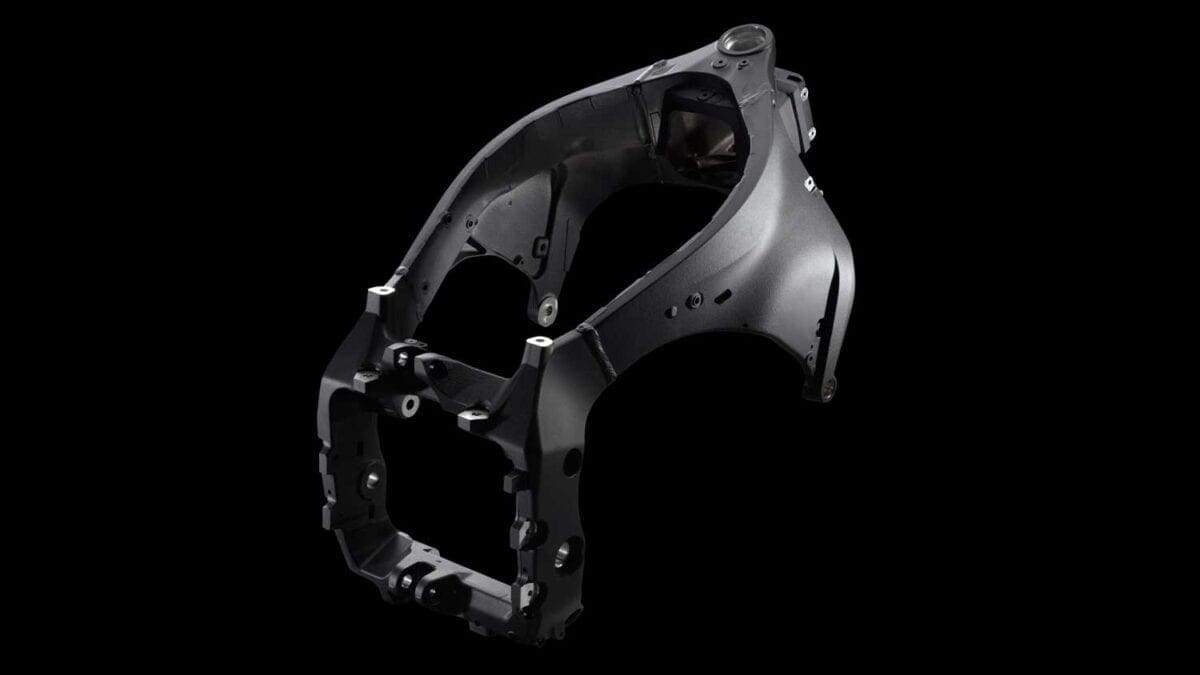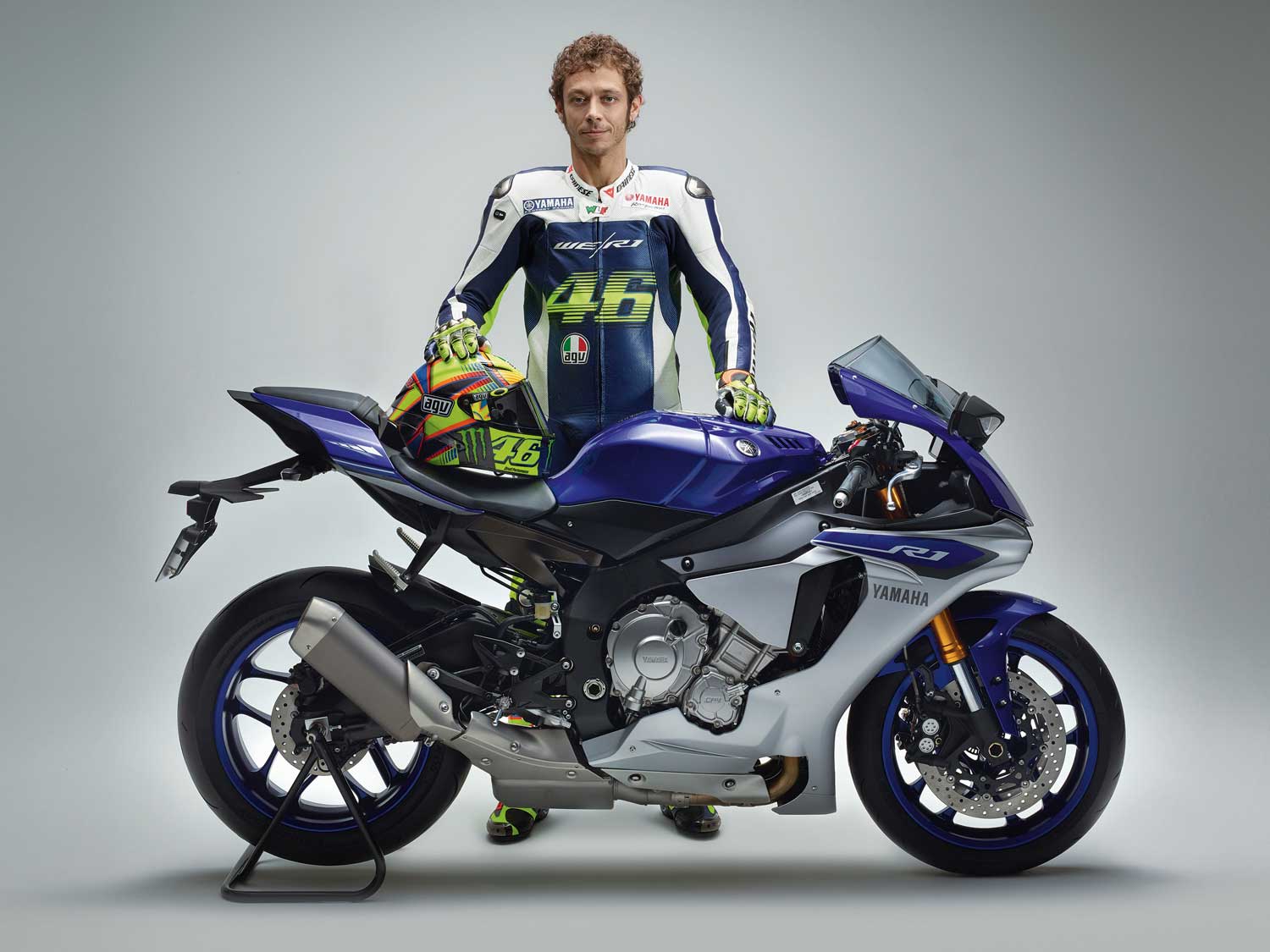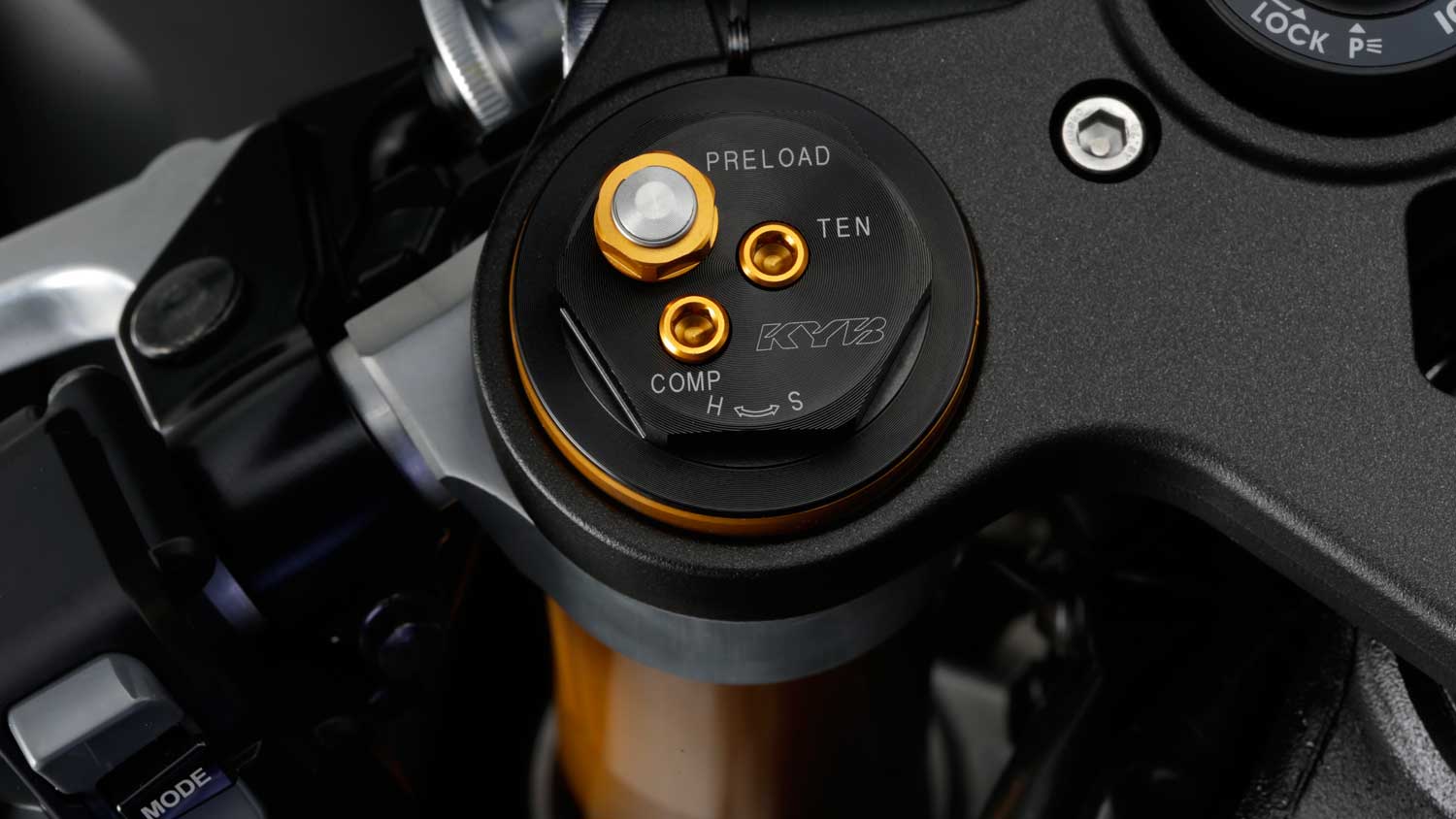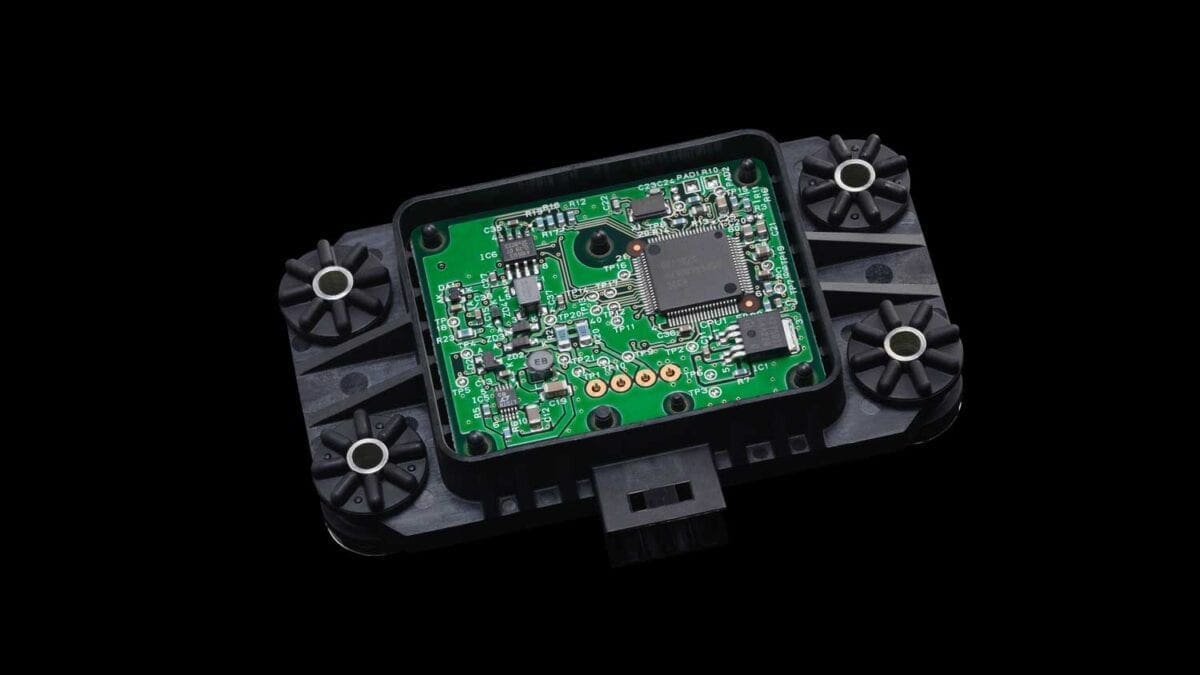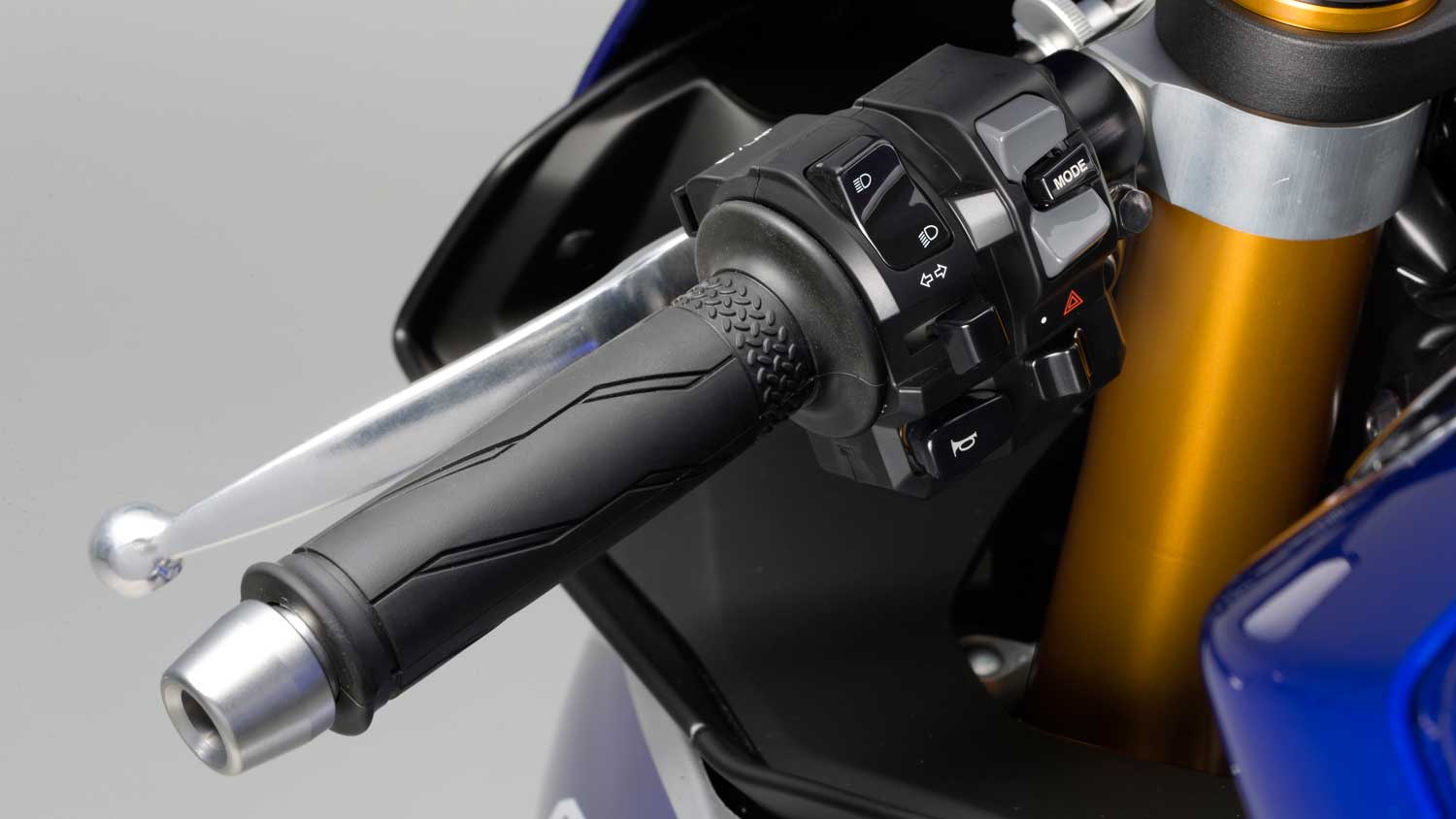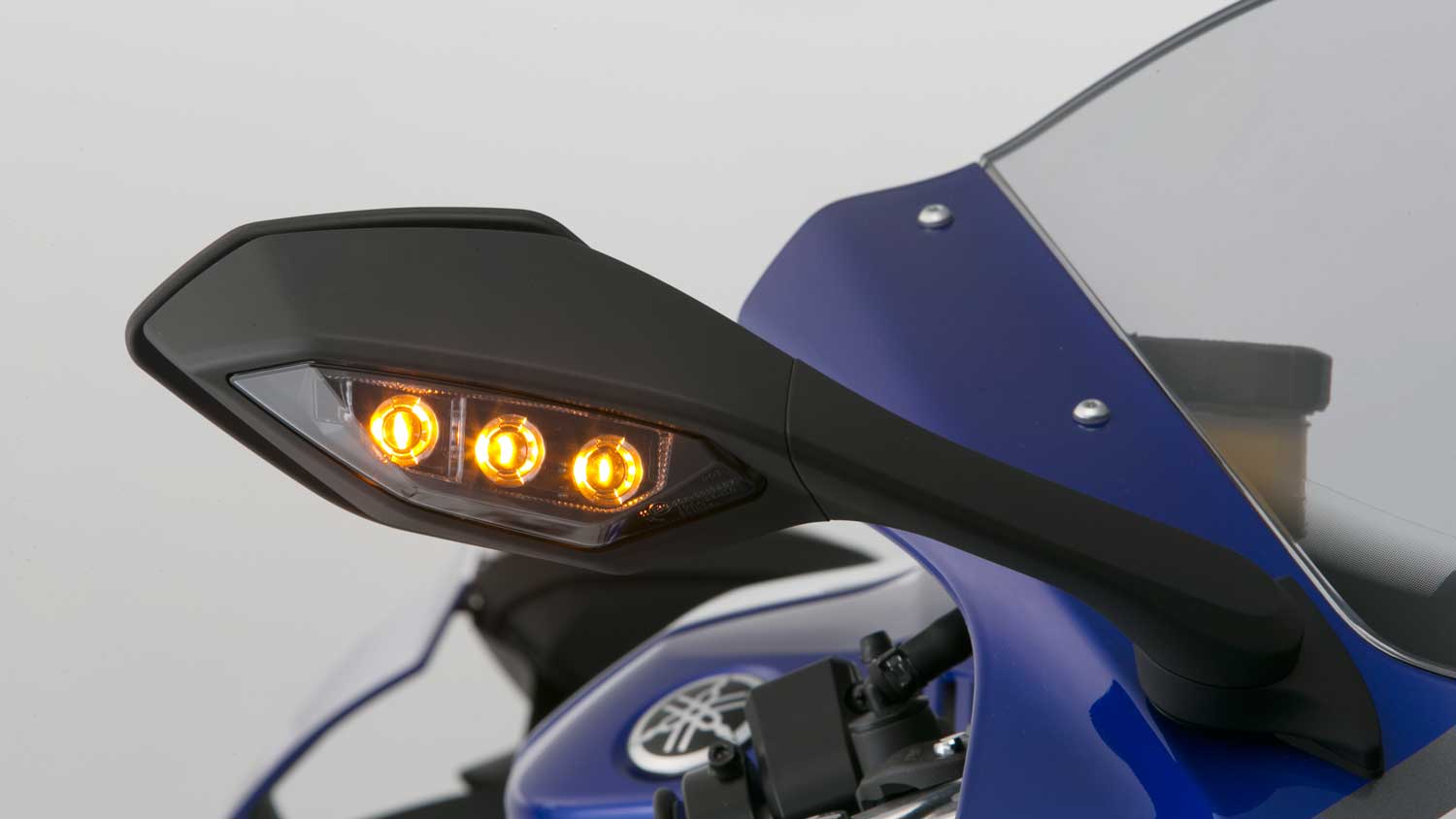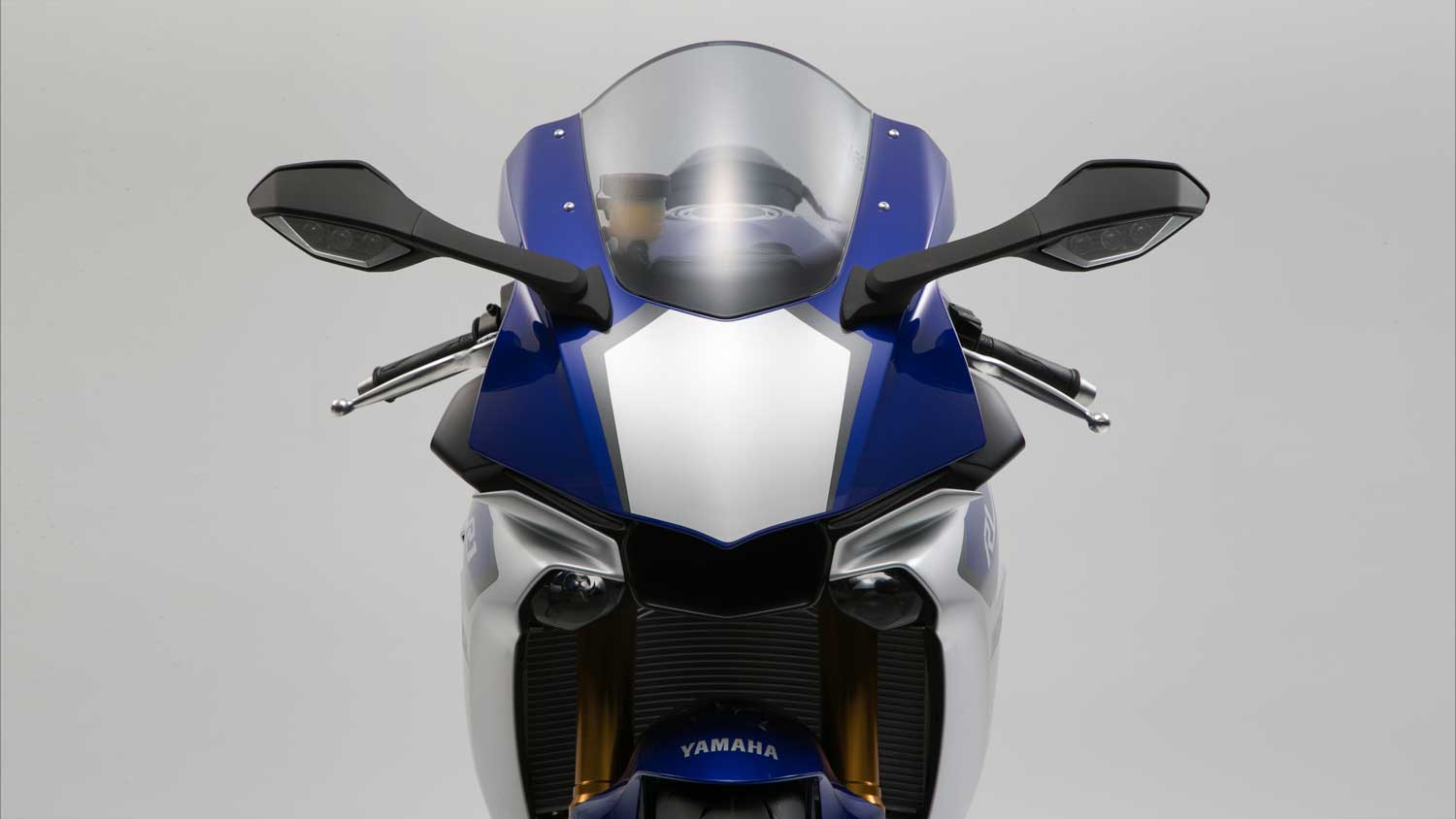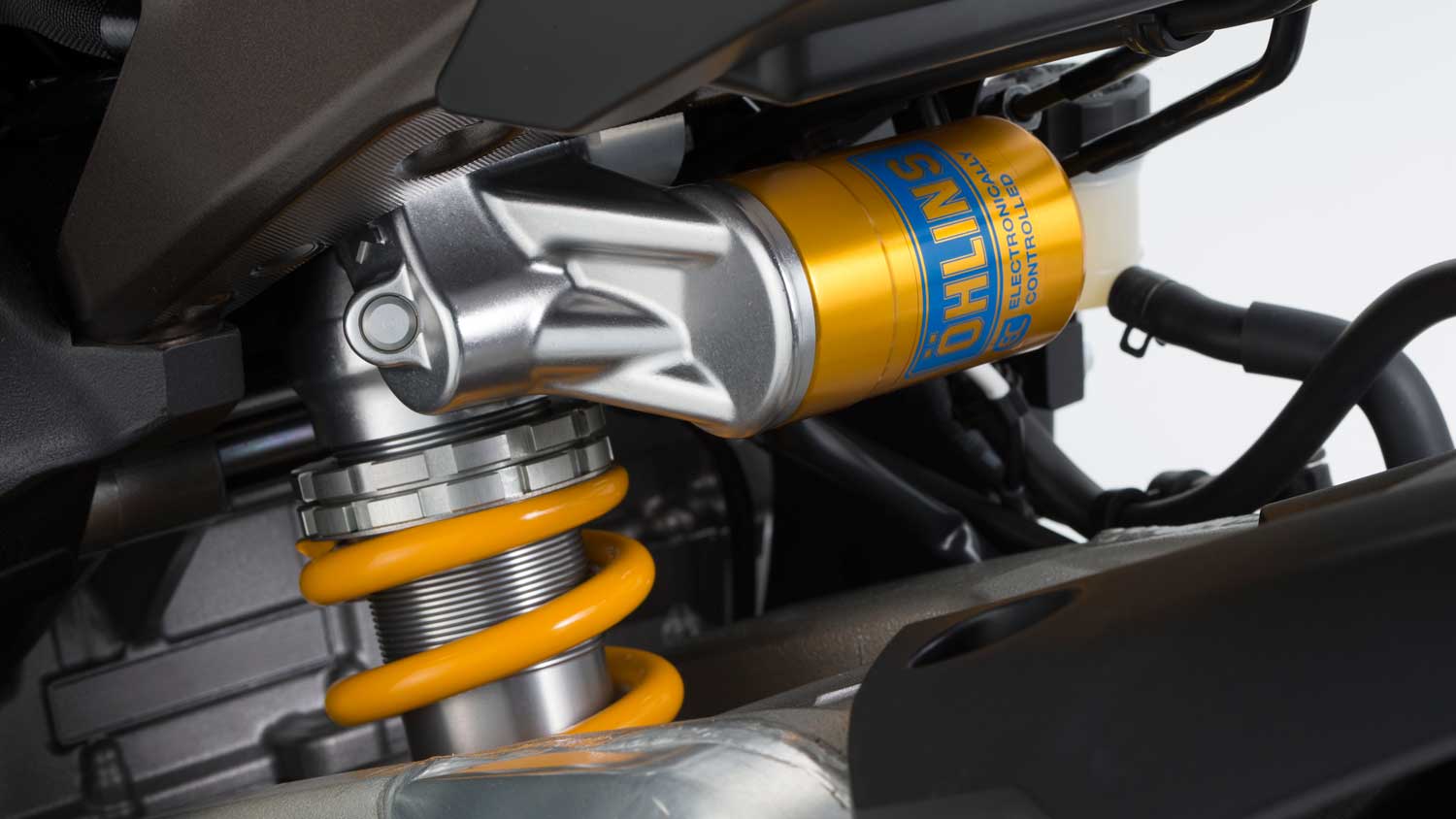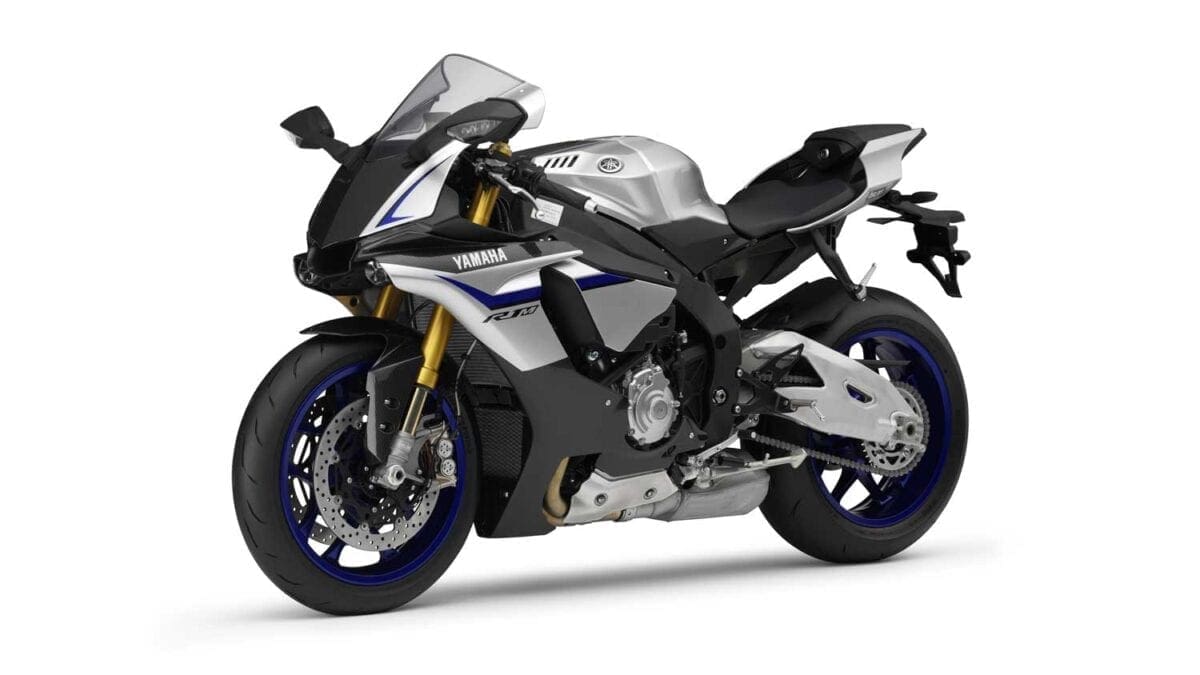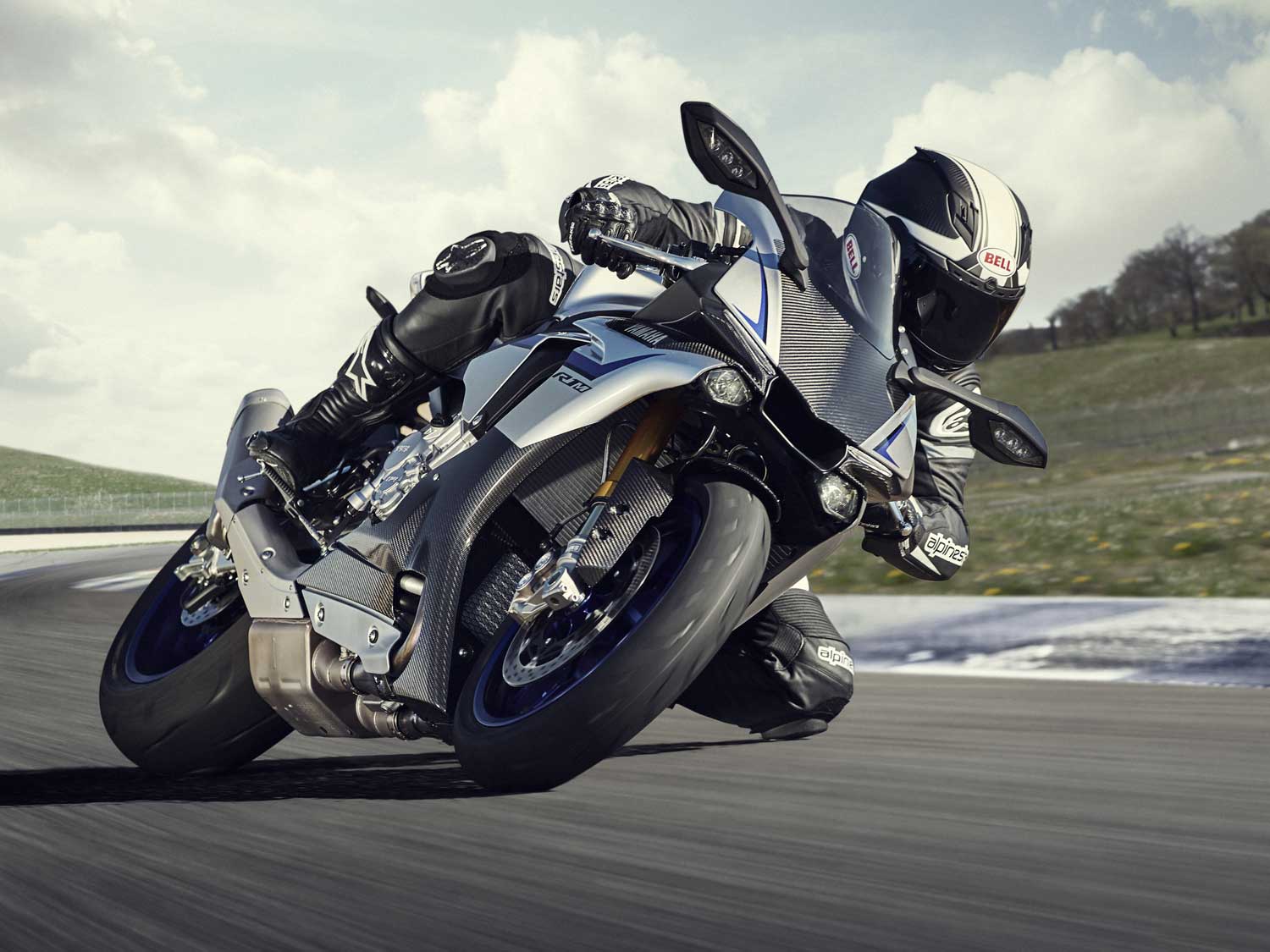The 2015 Yamaha R1 is a bike designed from scratch to reinvigorate the flagging supersport market by offering an experience as close as possible to the MotoGP YZR-M1.
The four-cylinder crossplane engine makes 200bhp@13,500rpm and 83lb-ft@10,000rpm (before taking into account ram-air) in an incredibly light 199kg wet weight. Advanced computer control makes this exciting power-to-weight ratio all the more accessible, with a six-axis Inertial Measurement Unit (IMU) offering ‘3D controllability’ in the form of banking sensitive traction control, slide control, front lift control, launch control, ABS and a linked brake system. A slipper clutch and quick-shifter are also standard.
The new engine features titanium fracture-split con rods that are 40% lighter than steel, and forged aluminium pistons, helping to make the engine more responsive. More weight saving is seen in the titanium 4-2-1 exhaust system, aluminium Deltabox frame, magnesium sub-frame and cast magnesium wheels.
The bike carrries a heavily sculpted 17litre tank, full LED lights, and dual 320mm disks with new monoblock radial calipers.
Also announced was the limited edition YZF-R1M, which swaps the KYB kit for Öhlins Electronic Racing Suspension; making constant adjustments based on feedback from the IMU. The R1M also features full carbon-fibre bodywork, and a Communication Control Unit (CCU) with GPS giving full datalogging including tracking, lean angle and more. This can be linked to an Android device to download data, as well as upload settings. The CCU is also available as an option on the standard R1. Buyers will need to apply for the R1M online from Dec 1st, and those lucky enough to snap one up will also receive an invitation to participate in the Yamaha Racing Experience.
Here’s what the press release had to say…
It was seventeen years ago that Yamaha unveiled the original YZF-R1 in the city of Milan. Light, powerful and agile, the R1 offered a whole new level of performance to the supersport rider. And in one brief moment the world of motorcycling was changed forever.
History has a habit of repeating itself. Now, two decades on from the arrival of the machine that transformed the bike world, Yamaha raises the bar once again with the release of its next generation superbike!
New YZF-R1. Everything is different, except the name.
Right from the beginning of the project it was agreed that this totally new high performance pure sport motorcycle would be developed from scratch without any restrictions. This gave our engineers and designers the opportunity to explore new concepts and designs, and create the kind of machine that, up to now, only factory riders could ever experience.
The team has been able to create a fundamentally different motorcycle that offers overwhelming performance with ultimate controllability. Built without compromise, the new R1 is ready to transform the bike world and showcase Yamaha’s vision for the future.
The new R1’s DNA remains the same as it ever was, but its purpose and design philosophy are entirely different. Featuring sophisticated MotoGP-derived technology, this new machine is a purely focused sport bike that has been developed primarily for the racetrack.
200PS – 199kg – with total 3D control
A compact and new inline 4-cylinder 4-valve crossplane engine develops 200PS without the use of ram air induction, and delivers a strong pulse of linear torque for outstanding running performance – while the new short wheelbase chassis benefits from weight reducing features such as a magnesium subframe and magnesium wheels in order to achieve a wet weight of only 199kg – with a dry weight of 179kg.
In isolation, these highly impressive figures of 200PS and 199kg show the outstanding racetrack potential of the new R1, but it is the widespread use of advanced electronic control technology that genuinely underlines the R1’s positioning as the next generation superbike.
A new digital era
The application of cutting edge MotoGP-derived electronic control technology represents a major leap forward in superbike design, and sets the new YZF-R1 apart from its peers. By monitoring every byte of data coming in from multiple sensors in the engine and chassis, the new R1’s advanced electronics enable riders to achieve the very highest levels of engine and chassis control.
Featuring the first ever 6-axis Inertial Measurement Unit (IMU) ever featured on a street-legal machine, the new R1 represents the dawning of a new digital era where all riders can experience total 3D controllability.
Fully equipped with banking sensitive Traction Control, as well as Slide Control, Front Lift Control, Quickshifter, Launch Control, ABS and a Unified Brake System – and much more – the next generation R1 introduces racers and track day riders to a new era of rider-adaptive performance. For the first time, all riders are given the opportunity to get a taste of MotoGP winning YZR-M1 technology – as enjoyed by Factory Riders Valentino Rossi and Jorge Lorenzo.
The game has changer forever. No longer is MotoGP technology the privilege of the few. Giving increased control with added confidence, as well as quicker lap times and higher levels of rider/machine unity, Yamaha’s vision of the future is here. We R1.
Yamaha YZF-R1 ENGINE
Newly developed 200PS crossplane engine derived from M1 technology
In order to achieve the goal of creating a totally new ‘High Tech Armed Superbike’, Yamaha have developed an all-new lightweight and compact engine that is about to open up a whole new era in high performance motorcycle design.
A newly designed crossplane crankshaft is at the very heart of the new 998cc inline 4-cylinder engine. By contributing towards the strong linear torque output, this technology gives a truly connected 1:1 relationship between the throttle and rear tyre – as well as an intuitive character that enables the R1 rider to exploit the high power output of the new YZF-R1 to its full potential.
The successful crossplane concept was originally developed for our MotoGP bikes with input from Valentino Rossi, and the next generation R1 continues to benefit from this innovative technology. The crossplane engine’s uneven 270° – 180° – 90° – 180° firing sequence gives each piston and con rod its own individual and separate movement to create a stronger low to mid range pulse – and this race-bred engine is also characterized by its exceptional exhaust growl.
Using advanced technology first seen on our YZR-M1 MotoGP machines, the new engine benefits from a range of features that are designed to increase air intake volume while at the same time reduce power losses. The use of this cutting-edge technology in every area of the new engine’s design and construction has succeeded in achieving a maximum power output (without ram air pressurization) of 200PS.
New crankshaft design
To underline just how different this new 200PS powerplant is to its predecessor, not only does it have a different bore x stroke, compression ratio, cylinders, cylinder head and fuel injection system – it also utilizes a completely new crossplane crankshaft design. The only thing that the next generation R1 engine shares in common with the current model is its name!
In order to be able to deliver excellent acceleration with instantaneous response, the inertial moment of the 2015 crankshaft is set at a level approximately 20% less than the current model. The new crankshaft incorporates a lightweight primary coupling balancer whose weights are positioned near the outer cylinders, and this subsequently reduces the inertial moment to strong acceleration and consistently high linear torque levels.
Highly efficient cylinder head and valve design
For highly efficient delivery of the fuel air mix, the new 2015 R1 engine is equipped with a newly designed 13.0:1 high compression cylinder head that features reshaped ports together with large intake and exhaust valves that have a diameter of 33mm and 26.5mm respectively. In addition to the large diameter valves, the valve angle is narrower than the current R1 to achieve a compact pent roof combustion chamber.
This new design ensures that the fuel-air mix is delivered more efficiently in to the combustion chamber – while the pent-roof shape induces a tumble into the mix that increases combustion speed and efficiency for increased power and superior torque characteristics.
The first titanium fracture-split con rods on a production motorcycle
To achieve a new level of pure sport performance, the new R1 engine is fitted with titanium fracture-split connecting rods. The specific titanium alloy used to manufacture the new con rods is around 40% lighter than steel, and this major reduction in weight gives the new engine an extremely responsive and potent character at high rpm.
The fracture-split design also ensures that the big end shape has an extremely high level of circular precision, giving consistent high rpm performance. On top of that, it reduces the tendency of the big end to deform at high rpm, giving excellent levels of reliability.
Lightweight forged aluminium pistons
Newly designed forged pistons utilize a box-shaped ‘bridge-box’ construction on their underside that gives high levels of rigidity combined with low weight – and for consistent cooling the new R1 engine uses a newly designed oil-jet piston cooling system.
With their low weight and high strength, these forged aluminium pistons make a significant contribution towards achieving a high power output together with strong linear torque and excellent throttle response. Furthermore, the use of new low-tension pistons rings and new piston pins with a diamond-like carbon coating (DLC) also helps to reduce frictional losses for increased performance.
New rocker arm valve drive mechanism
For the first time in its history, the R1 adopts a new rocker arm valve drive mechanism with a lever ratio that gives a higher valve lift than the cam height, while also decreasing the load on the cam for reduced frictional losses. Featuring an extremely hard diamond-like carbon (DLC) coating, the new rocker arm design plays an important role in contributing towards the new engine’s high power output and outstanding response.
High volume air intake system
To optimize the efficiency gains made by the newly designed cylinder head and valve drive mechanism, the next generation R1 is equipped with a large capacity 10.5 litre airbox. Being over 23% larger than the design used on the current model, this new airbox delivers increased volumes of fresh air into the Yamaha Chip Controlled Intake (YCC-I) funnels. The YCC-I consists of sets of long and short funnels that are electronically activated to match the prevailing engine speed for optimum power output and torque characteristics.
Advanced 2-directional fuel injectors
The new R1 is equipped with a Yamaha Chip Controlled Throttle (YCC-T) operating a newly developed fuel injection system featuring 2-directional 12-hole main injectors that direct their high pressure spray at the back of the two new large diameter intake valves.
This new design increases combustion speed by minimizing the amount of fuel that hits the port’s walls, giving higher levels of power and improved torque characteristics. The new fuel injection system also features secondary injectors that operate at higher engine speeds – and in order to reduce the effects of combustion heat, these secondary injectors deliver their fuel spray from the upper part of the intake funnel.
Lightweight titanium 4-2-1
To enable the new engine to attain peak power and also to enhance the linear torque characteristics, the 2015 R1 is equipped with a newly designed exhaust system manufactured mainly from titanium. Its compact muffler contributes towards the mass centralization that is a key feature on this advanced new superbike.
The four titanium header pipes merge to form two pipes beneath the engine, and then flow into a large capacity 5.2 litre chamber where the exhaust pressure is dampened before the gases enter the muffler via a newly designed exhaust valve. At low to mid range the exhaust gases flow through only one of the two passages within the chamber, and at higher revs a servomotor controlled valve located between the chamber and muffler opens to allow the high pressure gases to pass freely through both passages.
By controlling exhaust pressure at all engine speeds, the new exhaust valve enables the muffler to achieve outstanding power output together with strong linear torque characteristics and good silencing performance.
Compact and lightweight assist and slipper clutch
The new assist and slipper (A&S) clutch has been designed to match the new engine’s high power and torque delivery, and as well as being 19% lighter than the current model’s clutch, its diameter is also reduced by 7%. The A&S clutch design features a specially-designed aluminium cam between the clutch boss and pressure plate that ensures excellent engagement during acceleration, together with reduced clutch pressure during rapid down shifting before entering a corner. When high levels of back torque occur the R1’s A&S clutch delivers a level of slip equivalent to around half-clutch function to give smoother and more efficient cornering for reduced lap times.
High-efficiency lubrication system
In order to achieve stable lubrication at higher rpm, the new engine uses a centralized method of delivering oil to each individual big end from the end of the crankshaft, resulting in minimal frictional losses. The lightweight magnesium oil pan uses a sunken bottom design that lowers the surface level of the lubricant.
By inhibiting the interference between the crank web and the oil, this design cuts power losses and contributes towards new R1’s high output. The adverse effect of air bubbles in the returning oil is reduced by the use of a ribbed crankcase design – and for consistently strong performance, an air-cooled oil cooler is located under the radiator.
Yamaha YZF-R1 Engine
Technical highlights
* New 998cc crossplane in-line 4-cylinder, 4-valve engine
* New crossplane crankshaft design delivers linear torque output
* Maximum power output of 200PS (without ram air pressurization)
* 79.0mm x 50.9 mm bore x stroke, high compression ratio of 13.0:1
* Lightweight titanium fracture-split con rods
* Lightweight forged aluminium bridge-box pistons
* Large diameter valves and high efficiency intake ports
* Rocker arm valve drive with diamond like carbon (DLC) coating
* 2-directional 12-hole injectors
* Low-tension piston rings
* Piston pins with diamond like carbon (DLC) coating
* Offset cylinder design
* Large capacity 10.5 litre airbox
* Titanium 4-2-1 exhaust with midship muffler and new exhaust valve
* Lightweight assist and slipper clutch
* High efficiency centralized lubrication system
* YCC-I and YCC-T
* Compact and lightweight radiator
Yamaha YZF-R1 CHASSIS
Lightweight Deltabox frame
The 2015 R1 features a newly designed aluminium Deltabox frame that has been developed to deliver a high level of precision handling performance.
Featuring gravity cast components that are welded together to form a single structural unit, the compact aluminium main frame offers an idealized balance of strength and rigidity. The newly designed crossplane engine is incorporated as a fully stressed member, and is mounted rigidly to the frame at four points – two at the cylinder head and two at the crankcase.
The new Deltabox frame is equipped with a high specification upward truss type aluminium swingarm that is manufactured from a mixture of gravity cast, forged and two-piece shell structure components to create a strong and lightweight structure.
Significant weight reductions have been achieved with the use of a magnesium rear frame, and the left-right asymmetric design of the main Deltabox structure also contributes towards weight reduction and overall compactness.
Compact 1,405mm wheelbase chassis with 199kg wet weight
Weighing in at just 199kg with full oil and fuel – and only 179kg dry – the R1’s racing DNA is evident in the design and construction of every component. As previously described, the new engine benefits from a number of weight saving solutions that makes it lighter and even more compact than the former design. The use of magnesium in the chassis construction together with the asymmetric frame layout also make an important contribution towards achieving the wet weight of 199kg.
A bike’s overall weight is one element affecting the handling character, and to gain maximum advantage from this low weight, Yamaha’s designers have focused on concentrating weight as close to the bike’s centre as possible.
While weight is a ‘headline’ feature, the compact dimensions of the new chassis also play an integral role in shaping the highly focused race-bred character of the R1. With a short 1,405mm wheelbase, this next generation R-series flagship has clearly been developed with circuit riding as the primary focus.
To put it in context, the new R1’s wheelbase is 10mm shorter than on the current model, and the new 570mm long swinging arm is 15mm shorter. Both the caster and fork offset are the same as the current R1, and for increased front-end feel the front axle diameter is increased by 3mm to 25mm.
YZR-M1 type forced air intake
The new large capacity 10.5 litre airbox is force-fed with pressurized fresh air, enabling the Yamaha Chip Controlled Intake (YCC-I) to run at optimal efficiency. Air enters the centrally located intake that sits between the two ‘hidden’ LED headlights and runs through the steering pipe, just as it does on the YZR-M1 MotoGP bike. Manufactured from plastic resin reinforced with glass fibre, this lightweight forced air intake system underlines the significant technology transfer taking place between the factory racing bikes and the new R1.
Track-developed front and rear suspension
The fully adjustable front and rear suspension systems have been developed by KYB in association with Yamaha for precision handling and effective power delivery on the circuit and highway use. The 43mm upside down forks give 120mm of wheel movement, and together with the large diameter 25mm front axle, the R1’s front end gives excellent damping characteristics with a predictable and planted feeling during braking and cornering.
At the rear end, the newly designed upward-truss swinging arm activates a link-type Monocross suspension system that is designed to optimize the transmission of engine power to track surface. The carefully balanced relationship between the pivot position, final drive sprocket position and the swinging arm’s length is designed to give stable, precise and efficient handling performance during acceleration, braking and cornering.
ABS with Unified Brake System for increased control
For the first time on any supersport class Yamaha, the new R1 is equipped with ABS (Anti-lock Braking System) and also Yamaha’s Unified Brake System. These advanced braking systems are designed to allow the rider to achieve high levels of controllability in different circuit or road situations.
With the Unified Brake System, operation of the front brake also generates a corresponding braking force at the rear, and when the rider operates both the front and rear brakes, the Unified Brake System controls the balance of braking force that is applied to each brake.
In each case the distribution of braking force is based on input from the 6-axis Inertial Measurement Unit (IMU)*, which takes into account such factors as banking angle and machine attitude. The only situation where the Unified Brake System has no control is when only the rear brake is operated by the rider.
Cast magnesium wheels
The 2015 R1 is equipped with magnesium wheels, featuring a star shaped 10-spoke design. The new cast magnesium wheels represent a weight saving of nearly 900g compared to a conventional alloy design. The front wheel is 530g lighter, and – compared to the current R1 – this weight reduction gives a 4% reduction in its inertial moment for greater handling stability, while the rear wheel weight by itself is cut by 340g to give an 11% decrease in its inertial moment.
Race-developed 17-litre aluminium fuel tank
Weighing 1.6kg less than an equivalent steel design, the R1’s newly designed 17-litre aluminium fuel tank features a deeply indented knee area, allowing the rider to tuck in close to the bike. As well as giving an efficient and secure riding position that helps to reduce drag, the race-developed tank design gives a high level of rider/machine unity by offering support during braking and cornering.
Dual 320mm front discs with new monoblock calipers
The high-specification front brakes utilize two 320mm diameter front discs that are equipped with newly designed monoblock 4-piston calipers and stainless steel hoses – as well as a newly designed brake lever. This sophisticated system delivers outstanding braking performance with high levels of feel and accurate feedback – and its lightweight design reduces the inertial moment around the front wheel axle to contribute towards lighter handling characteristics.
The compact rear brake system uses a 220mm diameter disc with a single piston pin-slide caliper.
YZR-M1 inspired cowling and windscreen with full LED lights
By using aerodynamic analysis to create a more efficient shape, Yamaha’s designers have succeeded in producing a cowl and screen that deliver a reduction of 8% in wind resistance. Not by chance, its central air intake and high windscreen have a strong resemblance to the YZR-M1, and its high aerodynamic efficiency helps to deliver lower lap times on the circuit.
In a further move to achieve a low overall weight, Yamaha’s designers have chosen to equip the new R1 with LED headlights and LED position lights. As well as being light and compact, LED lights deliver high luminosity while also requiring a low wattage.
The two new small diameter LED headlights are positioned on either side of the central air intake, and are located much lower than on other supersport models – and because of their compact design they appear to be virtually hidden in the new front cowl, giving the R1 a unique ‘face’ that expresses its racing pedigree.
One other striking feature is the use of linear position lights that are located within the front cowl. The narrow and straight lines of these twin LED position lights come on when the ignition is activated, and they give the R1 a truly unique frontal expression. When the ignition is turned off, the LED position lights gradually lose their luminosity.
Race and circuit-ready features
Racers who are looking for winning performance – as well as those advanced riders who demand the ultimate track day machine – constitute a significant part of the new R1’s target market. With this in mind, Yamaha have once again looked to the YZR-M1 and developed a new race-specification seat with a wide rear section and angled sides that gives freedom of movement when braking or weight shifting for corners.
The seat design has been developed in conjunction with the new aluminium tank whose deep knee recesses allow the competitive rider to adopt a compact and active racing position that gives a heightened feeling of rider-machine unity.
Yamaha YZF-R1 Chassis
Technical highlights
* Newly designed asymmetric aluminium Deltabox frame
* Compact and short wheelbase design
* 199kg wet weight / 179kg dry weight
* Magnesium rear frame with aluminium truss-type swingarm
* YZR-M1 type central forced air intake
* Race-developed aluminium 17-litre fuel tank
* KYB 43mm front forks with 120mm travel
* Bottom-link type Monocross rear suspension
* Lightweight cast-magnesium wheels
* ABS with Yamaha Unified Brake System
* Twin 320mm front disc brakes with new monoblock 4-piston calipers
* 220mm rear disc with 1-piston pin-slide caliper
* Unique new front face with LED position lights and compact LED headlights
* Wide seat with race-developed fuel tank for optimal riding position
* Mirrors with integral front flashers
* Aluminium under protector
* Rear mudguard manufactured from carbon fibre reinforced thermoplastic resin (CFRTP)
Yamaha YZF-R1 ELECTRONIC CONTROLS
Every racer and track rider is always searching for total control. Because with total control comes higher cornering speeds, lower lap times, increased levels of excitement and reduced rider stress.
The all-new YZF-R1 comes with the most advanced electronic control technology ever seen on a production motorcycle, an accordingly it offers its rider the chance to attain their true potential. No longer is mechanical superiority enough to stay at the top. The digital era has arrived, and with its total 3D controllability, the new YZF-R1 makes the impossible possible. We R1.
6-axis Inertial Measurement Unit (IMU)
For the first time on any production motorcycle, the new R1 is equipped with a highly sophisticated 6-axis Inertial Measurement Unit (IMU) that instantaneously delivers comprehensive machine running data to the ECU.
Developed exclusively for the new R1, this 6-axis IMU consists of three gyro sensors that measures machine pitch, roll and yaw, as well as three G-sensors that transmits data on forward/backward, left/right and up/down acceleration. By constantly analysing this data 125 times per second, the IMU is able to establish the R1’s position and behaviour – including lean angle, slide speed and pitching rate. Data is then sent via a CAN system (Controller Area Network) to the ECU that makes real time calculations and instantly adjusts the R1’s various electronic control systems in order to achieve optimum performance with high levels of controllability.
The significance of the 6-axis IMU is not limited to its ability to give precision control via the ECU to adjust the fuel injection volume, ignition timing and throttle valve opening. What makes this technology so ground-breaking is its ability to deliver precise data on every aspect of running machine attitude, and this in turn has enabled Yamaha to equip this new superbike with the most advanced MotoGP technology, such as a banking angle sensitive rear wheel Slide Control System (SCS) and Traction Control System (TCS).
For the first time ever, racers and track riders have access to a race-ready production motorcycle that, through the use of the advanced electronic control systems described in the next section, enables every rider to attain their full potential on the track.
New banking angle sensitive Traction Control System (TCS)
One of the advanced new control technologies that has been made possible by the use of the 6-axis Inertial Measurement Unit (IMU) is a newly developed Traction Control System (TCS) that takes account of banking angle when controlling rear wheel drive force.
TCS is able to optimize the drive force to the rear tyre by monitoring the difference in speed between the front and rear wheels, and if it detects that rear wheel traction is being lost, the ECU adjusts the throttle valve opening, fuelling and ignition timing accordingly.
The R1’s newly developed TCS takes the concept to the next level by using additional data relating to the bike’s banking angle when calculating the optimum rear wheel control settings. For example, when the R1 is cornering at a high banking angle, the IMU’s sensors will activate the TCS to a higher level of control than when the motorcycle is upright – allowing the R1 rider to achieve optimum performance on a circuit, or whether powering out of a corner or accelerating in a straight line.
Slide Control System (SCS)
Just two years after introducing the technology on our MotoGP bikes, Yamaha is making history by offering our customers the opportunity to experience the most sophisticated electronic control technology available on a production motorcycle.
Using data from the revolutionary new 6-axis IMU, Yamaha’s patented Slide Control System (SCS) is designed to limit sidewards movement of the rear tyre by adjusting the engine’s output to an optimal level via the ECU when a slide is detected. This advanced new system works in association with the new banking angle sensitive TCS, and this high level of electronic control enables riders raise their game.
Front LIFt control system (LIF)
The third weapon in the R1’s control armory is its LIFt control system (LIF) that has been developed to control front wheel lift when accelerating hard. Once again, this use of this electronic control system has been made possible by the installation of the 6-axis IMU, and, the new LIF helps achieve a higher level of machine control for reduced lap times.
Launch Control System (LCS)
For fast, smooth and efficient starts, the Launch Control System (LCS) restricts engine rpm to below 10,000rpm even at full throttle. This control system also uses information from the TCS and LIF systems in order to maintain an optimum level of engine output when accelerating away from the start line, allowing the rider to concentrate fully on the crucial first few seconds of any race.
Quick Shift System (QSS)
Racers and track day riders will benefit greatly from the 6-axis IMU, TCS, SCS, LIF and LCS – and another significant piece of electronic control technology that is designed to reaffirm the R1’s race ready specification is its Quick Shift System (QSS). A sensor on the shift lever rod detects when the rider is upshifting, and the QSS sends data to the ECU that cuts drive torque to the engaged gear for swifter gear shifting.
Power mode selection (PWR)
The newly developed Power mode selection (PWR) gives the professional racer and track day rider the option to choose from a selection of four different adjustable running modes. This new PWR system is a further development of the proven Yamaha D-MODE system, and the four different control maps regulate the R1’s throttle valve opening in relation to the throttle position.
Yamaha Ride Control system (YRC)
The new R1 comes with a Yamaha Ride Control system (YRC). The YRC offers 4 grouped presets for quick and simple ‘one-click’ selection of all electronic controls through easy handlebar switches. In the YRC each of the control modes can be freely adjusted into new combinations based on user preferences and riding environment.
Optional Communication Control Unit (CCU)
YZF-R1 customers looking for the ultimate package can specify the fitment of the optional CCU. Full information is given in the YZF-R1M section.
Digital instrument panel with Thin Film Transistor (TFT) LCD design
With its wide array of electronic controls, the new R1 produces a mass of information, and Yamaha have developed an effective new rider-machine interface that conveys the data in a clear and intuitive manner. The rectangular single screen is 109mm wide, and is constructed using a Thin Film Transistor (TFT) liquid crystal display that significantly reduces reflectivity to give a clearer view of the information.
To achieve a high definition colour display, the LCD uses a very small dot size that gives the bar-type tachometer, acceleration meter and brake pressure display a solid and easy to read appearance – and the panel can be set to either ‘Street’ or ‘Track’ mode with a choice of a black or white background, depending on the situation. In addition, there’s also an ambient light brightness sensor that automatically adjusts the panel’s backlighting level to suit the prevailing conditions.
In ‘Street’ mode the display features items such as gear position, while the tachometer bar display uses different colours as the revs increase, allowing the rider to instantly comprehend the data. Other items available in ‘Street’ mode include odometer, tripmeters, real-time fuel efficiency, average fuel efficiency and amount of fuel consumed. Icons at the top and bottom of the display also show whether specific control functions such as the TCS and SCS are switched on, and which power mode is selected.
In ‘Track’ mode the display shows specific information with a high degree of clarity, such as lap number, lap times and a stopwatch function. The bar type tachometer display starts at 8000rpm and runs to the red line, and the gear position indicator is prominently displayed to the right of the panel. For easy post race analysis, each display has a memory function that enables lap by lap analysis.
Yamaha YZF-R1 Electronic controls
Technical highlights
* Highly sophisticated Electronic Control package
* 6-axis IMU for 3-dimensional motion detection
* Constantly monitors bike position and behaviour
* Measures lean angle, slide speed and pitching rate
* First ever on a production motorcycle
* 32-bit CPU gives 125 calculations per second
* Gyro sensor for pitch, roll and yaw
* G-sensor measures front/rear, up/down and right/left motion
* Enables the use of other high-tech electronic controls
* Banking angle sensitive Traction Control System (TCS)
* Rear wheel Slide Control System (SCS)
* Front LIFt control system (LIF)
* Launch Control System (LCS)
* Quick Shift System (QSS)
* Adjustable 4-position PWR power mode selection system
* Yamaha Ride Control (YRC) function
* New digital instrument panel with Thin Film Transistor (TFT) LCD
* High definition anti-reflective design
* Coloured display with choice of white or black backgrounds
* Selectable ‘Street’ and ‘Track’ modes showing different data
* Optional Communication Control Unit (CCU) with data logging and Wi-Fi set up
Yamaha YZF-R1 DESIGN
YZR-M1 inspired
In 2013 Yamaha Motor re-affirmed ‘design excellence’ as one of the key elements in new product creation, and defined the company’s design vision for the future as ‘Refined Dynamism’.
A side view that expresses light weight, slimness and compactness
One of the most striking design features of the new R1 is the compact surface area when viewed from the side. The use of a low set fuel tank and a short nosed, low-set front cowling – combined with a large open space under the seat – form a silhouette that is markedly smaller than the current model. Other significant design features that accentuate the R1’s light and compact side view are its short 1,405mm wheelbase, as well as the use of the centrally-located mid-ship muffler.
The overall feeling of lightness is also enhanced by the new cowling’s ‘cross-layered wing’ design that has layers of bodywork smoothly interlocking with each other. There are also large outlets in the side cowl and undercowl that expose various elements of the engine and inner aerodynamics to accentuate both the lightness of the new R1 and its high-tech design.
Pure YZR-M1 racer DNA with rider-machine unity
The body design of the new R1 has been shaped by the demands of the racetrack, and for this reason we have used Yamaha’s winning MotoGP bike as our inspiration. With its central air duct and high, broad-shouldered front cowl and screen – as well as large outlets in the side cowling – the YZR-M1’s influence on the new R1’s body design is unmistakable.
Achieving rider-machine unity is crucial for success on the race circuit, and every element of the body design has been developed with this goal at the forefront of our designers’ minds. The low-set fuel tank with its highly indented knee pockets enables the rider to sit ‘in’ the new R1 and take full control – and the wide seat gives greater freedom of movement during cornering and braking.
New face design with a ‘headlight-less’ look
One of the most revolutionary design features on the new R1 is its radical new face with a unique ‘headlight-less’ look. In place of the usual twin headlights, this front cowl is equipped with thin and straight LED position lights, while the compact new LED headlights are located within the leading edge of the side cowling. This exclusive design gives the 2015 YZF-R1 a ‘race-ready’ expression that confirms its circuit-focused character and M1 race-bike DNA.
Aerodynamic and lightweight body components
Wherever any external component sits in the airflow – such as mirrors and tail – they have been designed to be aerodynamically efficient, and this not only helps to reduce drag, it also reinforces the feeling of speed and lightness of the new R1. Special attention has been paid to the design of the rear cowl so that it draws air into the machine, and other features – such as engine covers, footrests and the ABS sensor cover – feature lightweight ribbed designs that reinforce the R1’s powerful image and reduce weight.
Body colours
The two new colour options underline the strength of the body design by using strong horizontal elements, and also emphasize the beauty of the machine’s components. The new colouring has also been developed to express the refinement, precision and attention to detail that are synonymous with Yamaha products.
YZF-R1 2015 Colours
Race Blu
Racing Red
Availability March 2015
SPECIAL EDITION YZF-R1M
Yamaha will produce a special R1 edition aimed at professional teams and highly experienced riders who demand the ultimate track and race performance. Featuring a range of highly sophisticated equipment – including Electronic Racing Suspension (ERS), carbon bodywork, a Communication Control Unit (CCU) and high-specification Bridgestone tyres – the YZF-R1M will be produced in limited quantities.
Öhlins Electronic Racing Suspension (ERS)
The YZF-R1M is equipped with an Öhlins Electronic Racing Suspension (ERS) system that is designed to further bring out the machine’s high level of performance on the race circuit.
This highly sophisticated new electronic front and rear suspension takes data from the 6-axis IMU and various sensors, and – based on the running conditions – the system’s Suspension Control Unit (SCU) makes integrated adjustments to the front and rear suspension. The chief advantages of the ERS include additional stability and control during braking by reducing fork diving, as well as improved cornering control and increased traction when exiting corners.
The key to the effectiveness of the ERS is the 6-axis IMU that is constantly monitoring the force and speed of every movement made by the YZF-R1M in 3 dimensions. By instantly analyzing the data from the IMU, the ERS assesses the running conditions, and at the same time the SCU calculates the ideal compression and rebound damping forces required for the front and rear suspension systems. Signals are sent to step motors that make instantaneous adjustments to the front and rear damping, enabling the YZF-R1M rider to benefit from a suspension system that is constantly being fine-tuned to work at its most effective setting.
This new Electronic Racing Suspension (ERS) offers a choice of ‘Automatic’ and ‘Manual’ modes, and within each of these two modes there is a selection of three different settings, giving the rider a choice of six unique settings to suit a wide range of preferences and different surfaces. When the ‘Automatic’ mode is selected, two of the running modes have a function that allows the rider to make fine adjustments to the damping to suit specific circuits or conditions.
For stable damping characteristics and more efficient adjustment, the front forks have separated damping functions, with the compression damping handled by the left fork, and the rebound damping handled by the right fork. The design of the ERS also permits the independent adjustment of the compression and rebound damping functions on the front and rear suspension systems, with initial adjustment being made by means of a hand operated knob.
Carbon bodywork
As a genuine ‘factory racer’, the YZF-R1M is equipped with a full carbon fairing, carbon front fender and carbon seat cover. The lightweight carbon cowling is coated in a clear finish and features upper, central and lower sections painted in a new specially developed metallic-look silver paint with racing blue accents that match the blue YZR-M1 style wheels.
Communication Control Unit (CCU) with GPS*
Fitted as standard equipment on the YZF-R1M, the Communication Control Unit (CCU) is a user-friendly interface with a comprehensive data logging function that allows riders to record a wide range of running data, including lap times, speed, throttle position, GPS tracking, lean angle and more. Data can be viewed, compared and shared on a tablet using a wireless connection with the R1’s CCU, enabling riders to analyze the previous race or track session and make any necessary adjustments. Riders can also use the CCU as a means of communicating with the Yamaha Ride Control (YRC) system and viewing, downloading or changing the running mode settings. By using a downloadable Android (4.2 on) app, the YRC settings can be amended wirelessly, allowing R1M riders to make quick and easy from a menu of factory or custom settings.
Exclusive design
Another exclusive feature on the YZF-R1M is the use of a highly polished aluminium fuel tank that features a clear finish to bring out the qualities of the material. To complement the aluminium tank and silver coloured fairing sections, the R1M’s upward-truss type swinging arm has also a highly polished aluminium finish in contrast to the standard R1’s black coating.
More exclusive design features can be seen with the gold-coloured front radial mount calipers, while the Öhlins Electronic Racing Suspension (ERS) use specially finished 43mm gold inner tubes on the front forks.
High specification tyres
The R1M’s specially developed tyres are the result of a joint collaboration between Yamaha and Bridgestone, the current MotoGP supplier. The 200/55-ZR17 rear tyre and 120/70-ZR17 front tyre use a special compound that has been formulated to optimize the performance characteristics of the R1 on the circuit.
Limited availability
Teams and individuals are asked to apply online via their national distributor for an offer of a machine, via the dedicated YZF-R1M application system that opens on December 1st 2014.
Once the distributor has received online applications they will establish contact between selected Yamaha dealers and potential customers to make an appointment to discuss the availability of the limited supply of machinery. It is anticipated that demand will exceed supply, and Yamaha distributors will use their discretion in managing the allocation of YZF-R1M units.
The Yamaha Racing Experience – YRE
All new YZF-R1M owners will receive an invitation to participate in the exclusive YRE Yamaha Racing Experience with their own machine.
The YRE will take place at 4 key European race circuits in July 2015, and during the one and a half days experience, participants will get the opportunity to meet special Yamaha V.I.P. guests and will take part in track sessions on their own R1M with top-level trainers. Yamaha technicians will also be on site to give professional race set-up advice.
YZF-R1M
2015 Colours
Silver Blu Carbon
Availability March 2015

